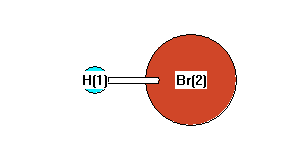Vibrational levels (cm-1) 
| Mode Number |
Symmetry |
Frequency |
Intensity |
Comment |
Description |
| Fundamental(cm-1) |
Harmonic(cm-1) |
Reference |
(km mol-1) |
unc. |
Reference |
| 1 |
Σ |
2559 |
2649 |
webbook |
|
|
|
|
|
vibrational zero-point energy: 1279.3 cm
-1 (from fundamental vibrations)
Calculated vibrational frequencies for
HBr (hydrogen bromide).
More spectroscopic constants are available at the NIST Physics Laboratory website:
Geometric Data

Point Group C∞v
Internal coordinates
distances (r) in Å, angles (a) in degrees, dihedrals (d) in degrees
| Description |
Value |
unc. |
Connectivity |
Reference |
Comment |
| Atom 1 |
Atom 2 |
Atom 3 |
Atom 4 |
| rHBr |
1.414 |
0.000 |
1 |
2 |
|
|
NISTdiatomic |
re Br(81) |
Cartesians
| Atom |
x (Å) |
y (Å) |
z (Å) |
| H1 |
0.0000 |
0.0000 |
0.0000 |
| Br2 |
0.0000 |
0.0000 |
1.4144 |
Atom - Atom Distances 
Distances in Å
| |
H1 |
Br2 |
| H1 |
|
1.4144 |
| Br2 |
1.4144 |
|
Calculated geometries
for HBr (hydrogen bromide).
Bond descriptions
Examples: C-C single bond, C=C, double bond, C#C triple bond, C:C aromatic bond
Connectivity
Dipole, Quadrupole and Polarizability
Electric dipole moment 
| State |
Config |
State description |
Conf description |
Exp. min. |
Dipole (Debye) |
Reference |
comment |
Point Group |
Components |
| x |
y |
z |
total |
dipole |
quadrupole |
| 1 |
1 |
1Σ |
C∞v |
True |
0.000 |
0.000 |
0.827 |
0.827 |
NISTdiatomic |
μ0 |
C∞v |
1 |
1 |
Experimental dipole measurement abbreviations: MW microwave; DT Dielectric with Temperature variation; DR Indirect (usually an upper limit); MB Molecular beam
Calculated electric dipole moments for
HBr (hydrogen bromide).
Electric quadrupole moment 
| State |
Config |
State description |
Conf description |
Exp. min. |
Quadrupole (D Å) |
Reference |
comment |
Point Group |
Components |
| xx |
yy |
zz |
dipole |
quadrupole |
| 1 |
1 |
1Σ |
C∞v |
True |
|
|
|
|
|
C∞v |
1 |
1 |
Calculated electric quadrupole moments for
HBr (hydrogen bromide).
Electric dipole polarizability (Å3)  Calculated electric dipole polarizability
Calculated electric dipole polarizability for
HBr (hydrogen bromide).











